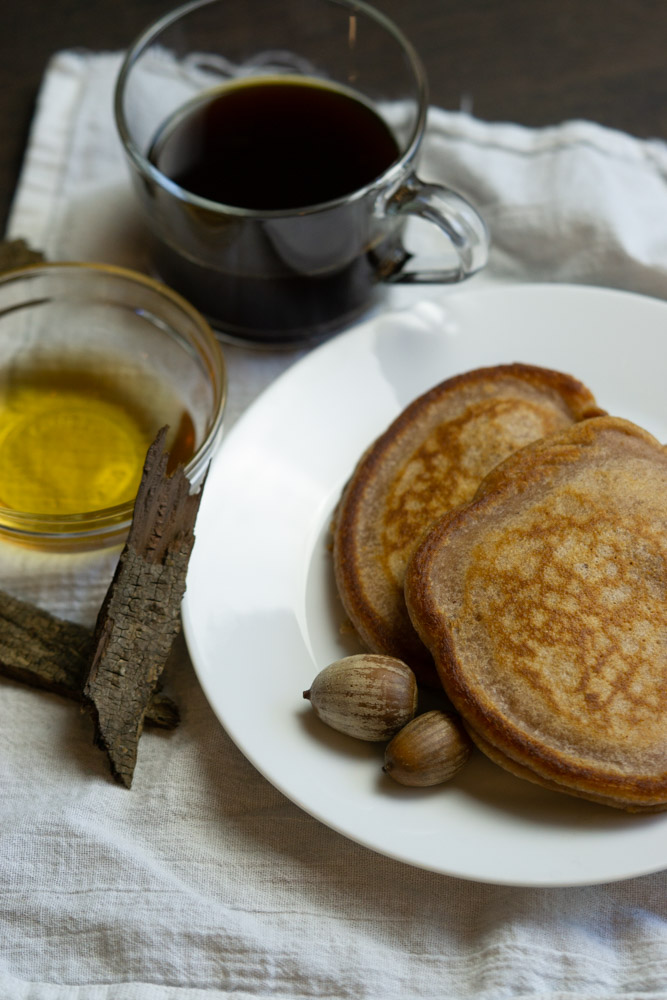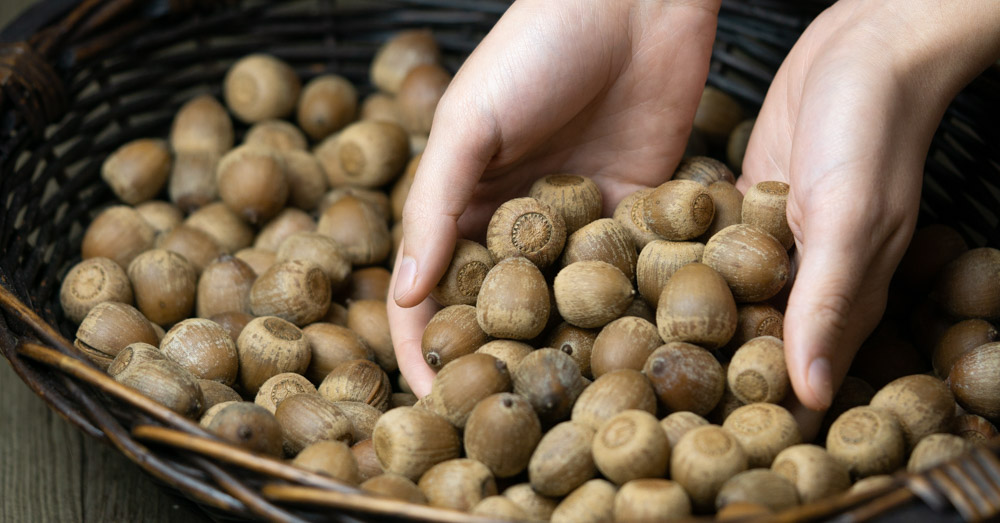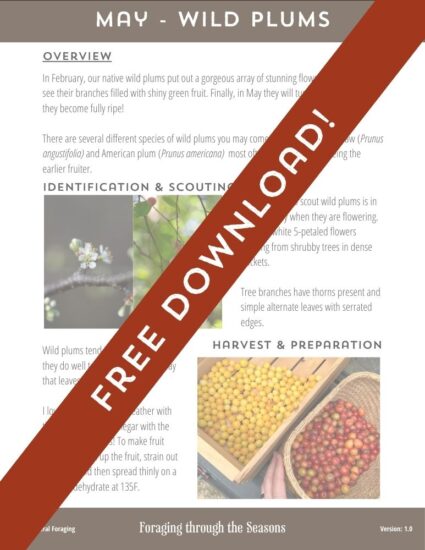Acorns As Food
Acorns were the very first wild food that I ever foraged. Many years have passed since I took my first bite of acorn bread, and still every new season I find myself processing and learning more about acorns as a staple food. I think that more people should be eating acorns. Foraging for acorns provides you with an abundant healthy wild food. It connects foragers with oaks, one of the most important trees in their ecologies, and it gives you calories without any dependence on industrial agriculture.

What is the Acorn Series?
The Acorn Series is a set of videos that show the entire process of gathering, cracking, leaching, and milling acorns for the purpose of food. We explain some of the pitfalls that can be avoided with foraging for acorns as well as delicious recipes that you can make!
Click “Watch on YouTube” below to be brought to a playlist with all of the videos!
Frequently Asked Questions
In making videos on the steps of processing acorns into food, there are a set of questions that consistently arise. In an effort to better address these questions, we have created this FAQ! If you have a question that is not answered in this section, please feel free to post it in our Foraging Discord Community. All are welcome to join!
Why eat acorns?
At face value, it seems like acorns are just too much work to process. After all, with the convenience of grocery stores providing more calories than one could ever need, why spend all the time to forage and process acorns?
There are a myriad of reasons, but a few stick out to me.
- Self Sufficiency – I find comfort in the experience that I have gained in being able to harvest and process calories from the wild. This is knowledge that used to be common place amongst the human race, but has now been largely lost, relegated to hobbyists and people groups that have not been completely overrun by civilization. I think it’s time that we rediscover this knowledge before it is lost entirely.
- Ecological Benefit – Every year, more and more native habitats are destroyed and cleared for industrial agriculture. By foraging for acorns, I can gather and eat calories that I don’t need to purchase from that industry. If more people ate acorns, maybe we could even start to reverse the loss of natural habitat.
- Health – Processed acorns yield a flour that is balanced between fat, protein, and carbohydrates. Further, many recipes made with acorns produce delicious results!
If you aren’t interested in self sufficiency, ecological benefit, or health, you may not be interested in foraging for acorns!
That looks like a lot of work, is it worth it?
When people see the whole process of taking fresh acorns and turning them into food, it looks like a lot of work and to be honest it is a lot of work. However, it would be an error to say that other bulk carbohydrate sources like: corn, potatoes, or wheat require far less work. Let’s make sure we are taking a few things into account when we tally the work required to process acorns.
From a self sufficiency point of view, if I wanted corn, I would have to grow corn. I need to set aside a plot to grow it. I need to plant and tend to the soil and the corn. After it has grown, I can finally harvest and process it into food.
Let’s contrast this with foraging acorns. I don’t need to tend to the oak trees which produce acorns, they are extremely hardy. I just show up and there they are, ready for me to harvest and process.
I want to be clear – I’m not saying that wild acorns are better than a cultivated food like corn, just that if we take the entire process of getting food on the table, acorns suddenly don’t seem like quite as much work.
I believe that any true self sufficiency strategy should involve a combination of gardening cultivated foods in additional to foraging wild food sources.
Are acorns poisonous?
Acorns contain tannins which should not be consumed in excess long term. [1] If you try to eat an acorn raw, you will likely find it to be a very unpleasant experience. Because of this, a myth has spread that acorns are “poisonous” which is not true. While, unprocessed acorns do have mild toxicity, with processing, they are entirely safe to eat.
Additionally, see my response, to “If acorns cannot be eaten raw, should we eat them at all.”
If acorns cannot be eaten raw, should we eat them at all?
I commonly come across this idea. “If you need to process them to make them safe to eat, they probably shouldn’t be eaten at all.”
I find this notion interesting. To start, we consume foods every day that need to be processed in some way before being consumed. Chicken is one of the most widely consumed meats in North America, yet I have never met anyone who expects to be able to eat chicken raw. We can also find numerous examples in the plant world: beans, potatoes, squash, are also not recommended to be eaten raw.
Another, wild food that is a staple in the Southeast, Poke Sallet, is a wild green that has been consumed for as long as humans have been here. Famously, Poke Sallet should never be consumed raw. The typical preparation involves boiling the leaves with 1-2 changes of water before it is consumed.
I’m sure there are many examples of foods, wild or not, that must be processed. The convenience of grocery stores has clouded our judgement. We have been trained to believe that food should be instant and easy to prepare. But when we buy a bag of flour, crackers, of chips, how many hours of harvest, processing, and preparation are behind the items conveniently stacked for us on the shelves?
Aren't you taking important food from wildlife?
I understand the concern here. If I am gathering and eating acorns, aren’t I taking important food sources from wild animals like deer or squirrels? The answer is – it depends.
The first factor is location. In most instances, I am gathering acorns from urban to suburban neighborhoods and parks. In these open areas where oak trees get ample sunlight, they drop a higher than normal volume of acorns. Additionally, there is far less wildlife present in these human areas than more wild spaces.
Oaks exercise a fruiting pattern called, “masting”. Every so often, trees (usually within a species) will drop massive amounts of acorns. There are several different theories behind exactly why this phenomenon occurs, but it has been observed that in mast years, far more acorns are dropped than wildlife can utilize. This is a perfect time for humans to take a step into the ecology and harvest and use the calories that would otherwise just decompose. (See “Why would you want to eat acorns?” for more details on how this can actually be an ecological net benefit.
I will say one more thing, particularly about squirrels, as they are closely associated with acorns in Western popular culture. I am not concerned about the common Eastern Gray Squirrel (Sciurus carolinensis). Where we have destroyed native habitats, leaving behind suburbs in their place, we have paved ideal habitats for the Gray Squirrel. [2]
Further, not only are populations of Eastern Gray Squirrel (and several other species of native North American squirrels) doing well domestically, they are thriving as invasive species (to the detriment of native species) in other parts of the world. [3]
In short – squirrels are doing just fine. They do not need any additional help from us. In fact, we have already inadvertently given them a lot. The species that do need help are those that we have destroyed the native habitats of that cannot thrive in our artificial habitats. See “Why would you eat acorns?” for how eating acorns can help these species.
Why do you dry acorns before cracking them?
It may seem counter intuitive that I dry my acorns when I will ultimately be leaching them in water. There are two reasons why I dry them first.
- If I needed to, I can store acorns long-term in their shells if they are completely dried
- Cracking dry acorns is easy, cracking fresh acorns is a bad idea. Fresh acorns will have flexible shells with acorn meat that clings to the inside. With a small batch this may not be a big deal, however, I process acorns in large amounts. It is infeasible to crack large amounts of acorns when they are fresh. Note: if you know you are going to process them immediately, you do not need to dry them completely, just enough that they can be cracked and separated from the shells easily
Sources
- Health effects, sources, utilization and safety of tannins: a critical review – Sharma et al.
- Eastern Gray Squirrels
(Sciurus carolinensis) Differ
in Abundance and Response
to Humans Across Urban
Habitats of St. Louis – Engel et al. - Health Status of the Eastern Grey Squirrel (Sciurus carolinensis) Population in Umbria: Results of the LIFE Project ‘U-SAVEREDS’ – Cruciani et al.




